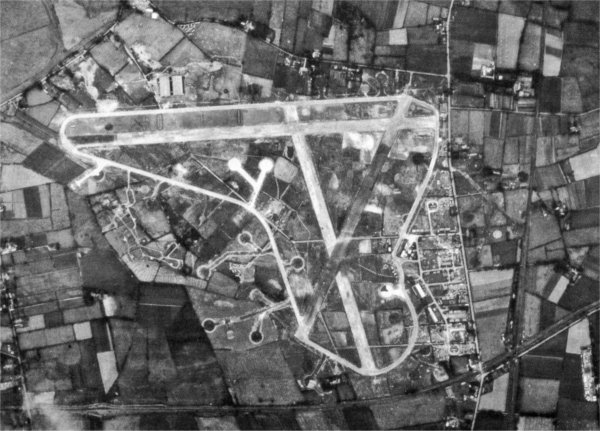 Long Kesh
Long Kesh
Validation date: 25 04 2015
Updated on: Never
Views: 5759
See on the interactive map:
54°29′22″N 006°06′16″W
Runway: ../.. - ...x...m - tarmac
Runway: ../.. - ...x...m - tarmac
Runway: ../.. - ...x...m - tarmac
Long Kesh airfield (also known as RAF Long Kesh and AAF232) was an airfield 16 kilometers southwest of Belfast, Northern Ireland.
The airfield was planned followed the outbreak of the Second World War, but due to construcion problems in the boggy site it was not officially opened until November 1941. 226 Sqn, flying Bristol Blenheims, had moved in the uncompleted airfield early in the previous month. They left again soon however, and were replaced by 231 (AC) Sqn, operating Westland Lysander and Tomahawks. Their stay did not last long, as they were replaced by 88 Sqn. operating Douglas Bostons (British designation for the A-20 Havoc). They were the first of a series of Army Cooperation (AC) units that spent time here during training.
From January 1942, Fighter Commands 74 Sqn provided shipping convoys with fighter cover over the Atlantic. For this purpose, their aircraft were fitted with long-range fuel tanks. During the first half of 1942, the US Navy commenced a thrice-weekly service between Hendon and Eglinton airfields near London and Londonderry respectively, stopping at Long Kesh to off-load and collect passengers, light freight and mail, using Lockheed 12 and Dakota aircraft. Long Kesh also became the end station for a towed glider service from Netheravon. The service was to give glider pilots experience in long range navigation.
In August 1942, Short & Harland, an aircraft manufacturing facility on the western end of the airfield, delivered its first Stirling bomber. A second followed in October and others followed until construction was moved to Maghaberry. In September 1942, Long Kesh became the temporary headquarters of 8th Air Force Composite Command, the organization with overall administrative responsibility for the USAAF presence in Northern Ireland. A more permanent location was found off base, to which the HQ moved in November. The airfield was then transferred to Coastal Commands 17 Group. It became a training facillity to teach pilots and crews the techniques of maritime operations, initially using Beaufort aircraft. From October 1943, the Beauforts were largely replaced by Hudson, Ventura and Oxford aircraft.
From March 1944 until February 1945, Long Kesh was used by numerous squadrons of the Fleet Air Arm who stayed for relatively short periods away from their parent aircraft carriers to enjoy some rest, to exercise with ground forces or to practice anti-shipping or bombing strikes using targets in the Lough Neagh and Strangford Lough areas. The best-remembered is 882 Sqn, equipped with Grumman Wildcat fighters. On the afternoon of Christmas Eve 1944, one of them, piloted by 19-year-old Peter Lock, developed an engine fire when flying from Long Kesh to the bombing and gunnery ranges on Lough Neagh. With great presence of mind, Peter successfully ditched the Wildcat in Portmore Lough where it settled on the bed of that shallow lake.
The only RAF flying unit based at Long Kesh in 1944, was 290 Sqn which arrived in March. Tasked to facilitate the training of anti-aircraft gunners, it was in heavy demand from the RAF Regiment, Army, Royal Navy and the USAAF gunnery school near Kilkeel, especially in the run-up to D-Day. 290 Sqn transferred to Scotland in February 1945, after which the airfield was left without flying units and relatively few visiting aircraft.
Aerial photo of RAF Long Kesh in 1942 (lisburn.com)
After VE-Day, the arrival on 17 July 1945 of three Dakotas from Hendon bearing Their Majesties the King and Queen, HRH Princess Elizabeth, their entourage and accompanying press corps, signalled the first Royal Visit to Northern Ireland by air. Other distinguished visitors included General Eisenhower and Field Marshal Montgomery, in August and September 1945, respectively. In September the Communications Flight of HQ RAF Northern Ireland was briefly based at the airfield, but they left for Sydenham in early December and the airfield closed not too long after that, in 1946.
RAF Long Kesh, its runways closed as indicated by the 'X' markings, photographed from 17,000ft on 11 Sep 1958 (ww2ni.webs.com).
In 1971, the disused airfield was turned into a temporary facility with Nissen huts to detain suspects who were arrested after "Operation Demetrius" was implemented by the Royal Ulster Constabulary (RUC) and the British Army. By 1972 there were 924 internees and by the end of internment on 5 December 1975 1,981 people had been detained; 1,874 (95%) of whom were Catholic and 107 (5%) Protestants.
